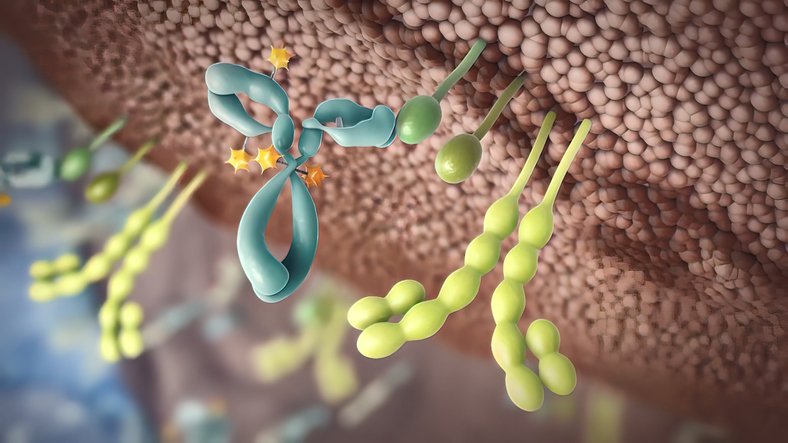There is a continued need for new myeloma therapies and combinations therapies. Below are some promising research areas on future treatments and therapies for myeloma. Some of these treatments (links in the left-hand sidebar) have been approved by regulatory agencies, while others are in the early stages of development and may only be available through participation in clinical trials.
Drug targets
Some emerging therapies for myeloma are known as immunoherapies (or immune cell therapies). Immunotherapy works with the body’s immune system to kill myeloma cells.
Immunotherapies must bind to a receptor (target), often a protein, to produce the desired effect. Myeloma cells have many different receptors on the surface of the cell that can serve as drug targets (on-target). These receptors may also be present in other cells in the body (off-target). Researchers select drug targets very carefully, aiming for treatments that target the myeloma cell directly and have minimal side effects. Below are some of the more common targets for myeloma treatments.
B-Cell maturation antigen (BCMA) is a protein that plays a role in how B cells (a type of white blood cell) develop and multiply. BCMA is more commonly found on the surface of myeloma cells. BCMA is rarely found on other cells in the body, which makes BCMA a promising target for myeloma therapies. BCMA expression in the body increases as multiple myeloma activity increases.1 Many therapies target BCMA, including:
- anti-BCMA monoclonal antibodies
- antibody-drug conjugates
- bispecific T-cell engagers
- BCMA-targeted adoptive cell therapies such as CAR-T
Cluster of differentiation 38 (CD38) is a protein commonly found on the surface of myeloma cells. CD38 is also found on blood and immune cells and in other places in the body, including tissues of the prostate, pancreas, kidneys, nervous system, and eyes.2 Different drugs and therapies may target CD38, including monoclonal antibodies, bispecifics, trispecifics, and CAR T-cell therapies.
Signaling lymphocytic activation molecule family member (SLAMF7) is a protein present in large amounts on myeloma cells and smaller amounts in certain types of immune cells, specifically Natural Killer (NK) cells. SLAMF7 also plays a role in the function of our immune system.
Cluster of differentiation CD138 (CD138) is a protein found on both normal and myeloma cells. CD138 can also be found in the body, such as the skin and gastrointestinal tract.3 CD138 is involved in tumorigenesis (the formation of tumors). Therefore, high levels of CD138 are linked to cancer growth and worsening disease.3
Learn about bispecific therapies, CAR T-cell therapies, immunocytokine therapies, and more by clicking on the links in the left-hand sidebar.
- Kleber, Martina, Ioannis Ntanasis-Stathopoulos, and Evangelos Terpos. “BCMA in Multiple Myeloma—A Promising Key to Therapy.” Journal of Clinical Medicine10, no. 18 (September 10, 2021): 4088. https://doi.org/10.3390/jcm10184088.
- Lancman, Guido, Dahniel L. Sastow, Hearn J. Cho, Sundar Jagannath, Deepu Madduri, Samir S. Parekh, Shambavi Richard, Joshua Richter, Larysa Sanchez, and Ajai Chari. “Bispecific Antibodies in Multiple Myeloma: Present and Future.” Blood Cancer Discovery 2, no. 5 (September 1, 2021): 423–33. https://doi.org/10.1158/2643-3230.BCD-21-0028.3
- Cho, Shih-Feng, Lijie Xing, Kenneth C. Anderson, and Yu-Tzu Tai. “Promising Antigens for the New Frontier of Targeted Immunotherapy in Multiple Myeloma.” Cancers 13, no. 23 (December 6, 2021): 6136. https://doi.org/10.3390/cancers13236136.





